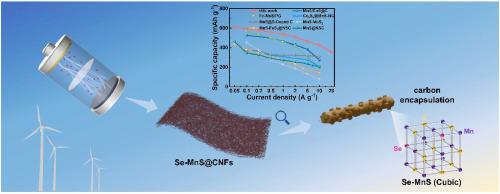在N, s共掺杂碳纳米纤维中构建具有硫桥键的硒掺杂MnS作为稳健钠离子电容器的阳极
IF 14.2
1区 材料科学
Q1 ENGINEERING, MULTIDISCIPLINARY
引用次数: 0
摘要
硫化锰具有理论容量大、储量丰富、无毒等优点,是一种很有前途的钠离子电容器负极材料。然而,缓慢的反应动力学,加上低电导率和大量的体积膨胀,导致较差的速率能力和相对较短的循环寿命,严重阻碍了其实用性。为了应对这些挑战,在N, s共掺杂碳纳米纤维(Se - MnS@CNFs)中精确地设计了硒掺杂MnS。实验结果表明,硒的掺入提高了MnS的晶格间距和电导率。此外,CNF涂层促进了Se-MnS与CNF之间Mn-S-C键的形成,有效地促进了Na+/电子迁移,同时防止了Se-MnS在(去)调解过程中的团聚和体积变化。这些优点使Se - MnS@CNFs阳极具有超常容量(0.05 ag−1时609.8 mAh g−1),卓越的倍率性能(20 ag−1时355.1 mAh g−1)和无与伦比的循环寿命(800次循环后保持89.1%的容量)。此外,利用一系列原位和非原位表征技术以及严格的理论计算,对Se - MnS@CNFs的钠储存机制进行了全面的研究。正如预期的那样,当与氮掺杂碳(NC)阴极耦合时,构建的Se - MnS@CNFs//NC钠离子电容器具有出色的能量和功率密度(146.1 Wh kg - 1/22000 W kg - 1)以及优异的循环寿命(6000次循环后保持79.6%的电容)。该研究为探索非金属原子掺杂MnS提供了新的视角,并为设计先进储能系统的快速动力学阳极提供了有效的方法。本文章由计算机程序翻译,如有差异,请以英文原文为准。

Construction of Se-doped MnS with sulfur-bridged bonds in N, S-codoped carbon nanofibers as an anode for robust sodium-ion capacitors
Manganese sulfide (MnS) has emerged as a promising anode material for sodium-ion capacitor owing to its significant theoretical capacity, abundant reserves, and non-toxic characteristics. Nevertheless, the sluggish reaction kinetics, coupled with low electrical conductivity and substantial volume expansion, result in inferior rate capabilities and a relatively short cycle life, which severely hinders its practicality. In response to these challenges, Se-doped MnS confined within N, S-codoped carbon nanofibers (Se–MnS@CNFs) has been precisely engineered. Experimental results reveal that Se doping enhances both the lattice spacing and electrical conductivity of MnS. Furthermore, the CNF coating facilitates the formation of Mn–S–C bonds between Se–MnS and CNFs, effectively promoting Na+/electron migration while preventing agglomeration and volumetric change of Se–MnS during the (de)sodiation processes. These advantageous properties endow the Se–MnS@CNFs anode with a supernormal capacity (609.8 mAh g−1 at 0.05 A g−1), remarkable rate performance (355.1 mAh g−1 at 20 A g−1), and unparalleled cycle lifespan (retaining 89.1 % of its capacity after 800 cycles). Moreover, a comprehensive investigation into the sodium storage mechanism of Se–MnS@CNFs was conducted utilizing a series of in-situ and ex-situ characterization techniques alongside rigorous theoretical calculations. As expected, when coupled with a nitrogen-doped carbon (NC) cathode, the constructed Se–MnS@CNFs//NC sodium-ion capacitor delivered outstanding energy and power densities (146.1 Wh kg−1/22000 W kg−1) along with excellent cycling life (79.6 % capacitance retention after 6000 cycles). This research contributes novel perspectives on the exploration of non-metallic atom-doped MnS and offers an efficient approach to designing fast kinetic anodes for advanced energy storage systems.
求助全文
通过发布文献求助,成功后即可免费获取论文全文。
去求助
来源期刊

Composites Part B: Engineering
工程技术-材料科学:复合
CiteScore
24.40
自引率
11.50%
发文量
784
审稿时长
21 days
期刊介绍:
Composites Part B: Engineering is a journal that publishes impactful research of high quality on composite materials. This research is supported by fundamental mechanics and materials science and engineering approaches. The targeted research can cover a wide range of length scales, ranging from nano to micro and meso, and even to the full product and structure level. The journal specifically focuses on engineering applications that involve high performance composites. These applications can range from low volume and high cost to high volume and low cost composite development.
The main goal of the journal is to provide a platform for the prompt publication of original and high quality research. The emphasis is on design, development, modeling, validation, and manufacturing of engineering details and concepts. The journal welcomes both basic research papers and proposals for review articles. Authors are encouraged to address challenges across various application areas. These areas include, but are not limited to, aerospace, automotive, and other surface transportation. The journal also covers energy-related applications, with a focus on renewable energy. Other application areas include infrastructure, off-shore and maritime projects, health care technology, and recreational products.
 求助内容:
求助内容: 应助结果提醒方式:
应助结果提醒方式:


